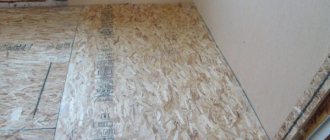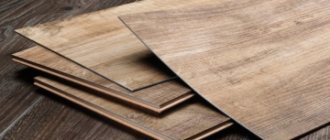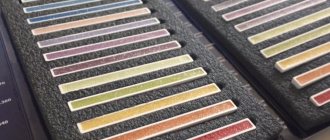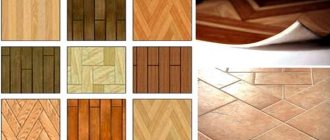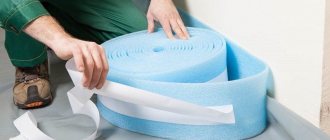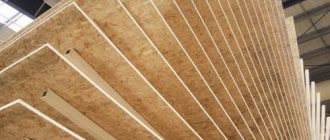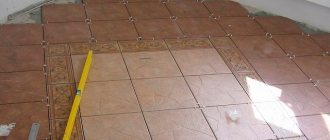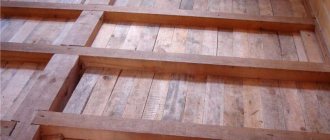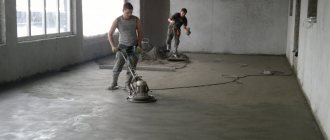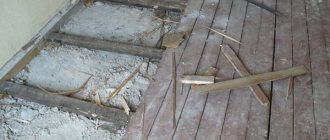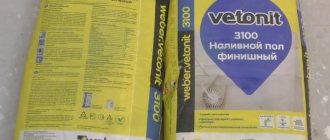The type and properties of the floor covering are the determining factors in the formation and maintenance of a favorable microclimate in the room. Warm floor tiles made from substances with a porous structure can give a feeling of comfort without installing a heating system. Adults and children get the opportunity to travel around the house barefoot. This is good for health, saves energy costs and eliminates the need to purchase different-sized indoor shoes.
What influences the choice of heated floors?
To help you choose a heated floor for tiles, you should pay attention to the following nuances:
- Functions . The power and, accordingly, the type of underfloor heating depend on whether the system will be primary, additional or alternative. If the heated floor is intended for additional heating, the choice is wider.
- Screed. It is necessary to decide whether a concrete screed will be used when installing the floor. The issue of its thickness may also be fundamentally important, especially if we are talking about a room with a low ceiling.
- Type of living space . If in private houses almost any solution is acceptable, then owners of apartments in high-rise buildings are often limited in the choice of heating systems.
- The cost of the system itself and its operation . Cheap equipment is not always the most economical. When choosing a heated floor, you should take into account everything: the cost of materials, the complexity of installation, the consumption and price of energy resources.
In any case, it is better to put a warm floor under the tiles, because the material is very cold to the touch and it is unpleasant to stand on it.
However, the type of system should be chosen wisely. It must fully perform its functions and use resources rationally.
When choosing a system, you must also take into account the features of its maintenance and repair. It is advisable to have easy access to the equipment in case of breakdown.
Decorative coating options
In the bathroom, in the kitchen, in the hallway, choose a coating that is easy to clean.
When choosing a floor covering, you need to take into account a number of factors that affect the efficiency of heating the room and the people living in it.
Products must meet the following parameters:
- resistance to high temperatures;
- immunity to constant heating and cooling;
- high thermal conductivity;
- environmental Safety;
- installation technology;
- ease of maintenance;
- strength;
- durability;
- resistance to abrasion and chemically active substances;
- texture, color and surface design.
Since flooring is installed to last for decades, the last thing to think about is the cost of materials. It is better to choose an expensive but high-quality coating, the condition of which you will not need to worry about until the next major renovation of the building.
Porcelain stoneware tiles do not lose their appearance, heat up quickly and transfer heat.
The best finishing options that are used when installing underfloor heating:
- Ceramic tile. The material is characterized by its relatively low cost, high thermal conductivity, heats up quickly, transferring energy with virtually no losses. There is a wide range of products of this type on sale, characterized by various design solutions. The downside is that the outer decorative layer wears off over time, and objects falling on the floor leave clearly visible chips on the surface. You should choose tiles of 5-6 hardness class, 4-5 wear resistance class and water absorption of 3–6%.
- Porcelain tiles. This is a more durable coating, but its cost is higher. The material has a uniform structure throughout its entire volume, due to which mechanical damage is not noticeable on its surface. The high thermal conductivity of porcelain stoneware ensures efficient heat transfer from the heating element to the room. The downside is that the coating imitates natural stone - this option does not suit the design of living rooms.
- PVC tiles. Warm floor tiles without heating retain their performance characteristics at any temperature, including negative ones. Its distinctive feature is a pleasant tactile sensation even when the heater is turned off. When heated, the material does not emit harmful substances. The average level of thermal conductivity allows the tiles to be laid directly on cable mats or infrared film. Warm floor tiles are easy to install; even a beginner can easily handle this process.
- Vinyl tiles. Warm vinyl floor tiles are an excellent solution for decorating a bedroom, kitchen, and even a child's room. Vinyl flooring has a multi-layer structure with an adhesive backing. It can be glued immediately after removing the protective film without using cement mortar or liquid nails. Ceramic inclusions ensure high wear resistance of products, and ultraviolet treatment ensures color preservation throughout the entire period of operation. Warm tiles do not change their properties when heated
When choosing, priority should be given to a material that can provide effective heating with minimal electricity consumption.
Pros and cons of different types of systems
In hardware and construction stores you can purchase the following types of heated floors:
Moreover, electric-water systems have appeared recently, so it is still difficult to judge their effectiveness and durability. But electric and water heating are time-tested. The pros and cons of these floors are well known.
We propose to consider in detail all the options for underfloor heating, compare their advantages, disadvantages, and limitations in the scope of application. This will make it easier to choose a suitable heated floor for the tiles, taking into account the operating conditions, type and purpose of the premises.
Option #1: water floor heating
A water floor is a system of pipelines with coolant, which is located between a concrete or wood base and the finished floor covering. The heated water enters the pipes either directly from the boiler or from the central heating.
You should not choose a water system for an apartment in a multi-story building. This is due to the inconvenience that may arise due to connection to centralized heating, and the possible consequences of accidents. The risks are too great. But for private houses there are no such restrictions.
Water systems are economical. Their installation allows you to reduce energy consumption by 20-30%, and in rooms with high ceilings - up to 50-60%. This becomes possible due to the fact that the temperature of the coolant in the pipes does not exceed 30-50°C. If the ceiling height in the house is higher than standard, then the air is not fully heated: 2-2.5 m above the floor level.
The design of a water floor is complex and is a multi-layered cake. Moreover, at each stage of installation you have to carefully carry out the work, otherwise accidents and leaks are possible. If this happens, the floors will have to be ripped out for repairs.
Properly installed water floors become a reliable and efficient source of heat. Ideally, they should complement or duplicate the main heating system. Another nuance: in order for the heating to be uniform and stable, you will have to take care of high-quality thermal insulation.
Option #2: electrical cable
Cable floors do not require any special care or maintenance, unlike hydronic systems. They can be installed in country houses or cottages where people do not live permanently, but visit them on weekends and holidays.
Laminate
This is a type of wood board with fibers that is very dense. The main layer is a decorative protective film.
Before starting calculations, all details are clarified. In addition to the main coating material, cement mortar and insulation are also considered.
If the room area is 50 m², then the thickness of the insulation, laminate and mortar is 4/1/0.2 cm.
The layers under the pipes will also be of three types: concrete and two insulation materials. The thickness of the elements under the pipe is 22, 2 and 4 cm.
After selecting the average coolant temperature, for example 40 °C, the upward flow values will be 72 W/m², and the maximum floor temperature will be 26 °C. These calculations allow you to determine which coating is best suited.
What type of heating should you choose?
Heating mats, water and electric water floors are best suited for tiles. The cable system option is worth considering if you have the skills to install such floors yourself or you can order such a service for a reasonable price. It is worth remembering that problems may arise with diagnosing and repairing breakdowns.
Film infrared floors are considered the worst solution, despite their efficiency and cost-effectiveness. They are perfect for installation under laminate, but do not “get along” well with tiles. Experts advise choosing a different, more practical heating option.
Features of ceramic foam manufacturing technology
The effect of a warm floor is obtained thanks to innovative technology, which involves filling the working ceramic mass with air bubbles. The result is a thermal insulation layer that does not give a feeling of cold when walking. When finishing a bath or kitchen with such tiles, there will be no need for rugs and installation of a heated floor system.
The working solution from which the flooring material is formed is called foam ceramics. Previously, a similar composition was used to produce blocks that were used to insulate stoves. Now Japanese developers offer tiles for finishing kitchen and bathroom floors. The strength of the material is achieved through the use of firing during the production process, which leads to the decomposition of organic compounds.
TOP 9 best manufacturers of heated floors
There are many good manufacturers of heated floors, but when choosing a heating system, it makes sense to buy not just a good one, but the best one and at a reasonable price. Domestic ratings are topped by the following brands:
These brands have proven themselves to be excellent. Their products undergo strict multi-stage quality control, and there are practically no complaints from customers.
All of these market leaders are deservedly popular. Another important plus: the systems are really inexpensive and economical.
Conclusions and useful video on the topic
All heated floors have features that manufacturers do not mention. We offer useful video tutorials and reviews. Thanks to them, you can choose the right system that is suitable specifically for your operating conditions.
Video instructions for choosing the best electric floor:
Video tutorial on laying tiles on an installed heated floor:
The main disadvantages of different types of electric floors:
Which warm floor is better for tiles can only be determined by the owner of the room. Only he knows everything about the operating conditions of the system, the intensity of its operation, and the desired temperature conditions. General recommendations are not suitable for everyone, so it is worth taking the time to choose the best heating option. The reward for your efforts will be warmth, comfort and savings in the future.
In two apartments I’ve never regretted it > won’t my feet be cold in winter?
It won’t happen if you don’t have the habit of walking around the apartment barefoot.
Well then, I don’t know, although I don’t rule out that it will be comfortable anyway.
> I don’t understand how you can wear socks, much less slippers, in your home.
Just imagine, there are such people 
I still haven’t found where to buy it, for 3 square meters of a wet room the price is 3500 rubles, they don’t really need a regulator, you can get by with a simple dimmer from IKEA
When carrying out repairs, many questions may arise. And often the questions are not related to how exactly to do this or that work. For many, it becomes a problem to choose one or another method of technology. So, many people are interested in the question of which heated floor for porcelain stoneware is better. It is known that heated floors are very popular and the modern market provides a wide variety of them. For example, water heated floor and electric. As for electric, there are several varieties. In this article we will provide you with interesting information that will help you understand which is the best heated floor for porcelain tiles to choose. As for porcelain stoneware, it is important to understand that it is a durable and reliable building finishing material. However, one of its features, thermal conductivity, reduces the scope of its use, for example, in residential premises and offices. Why? Without heating in the cold season it is very cold. This is the reason why they put a warm floor underneath it. Accordingly, a reasonable question arises, which technology is best to choose.
Water heated floor
Laying porcelain stoneware on a heated floor with a water circuit is in great demand today. Its essence lies in the formation of several layers. The heating cake consists of the following components:
- Rough screed.
- Waterproofing.
- Thermal insulation.
- Reinforcement.
- Water circuit.
- Clean screed.
- Finishing with porcelain stoneware.
Each of the layers requires a certain amount of space. For example, most of the heating pie for a heated floor under porcelain stoneware is occupied by thermal insulation and screed. The latter is an excellent thermal energy accumulator. And with all its positive sides, there are several negative ones. For example, if you have a limited ceiling height, then installing a water-heated floor will not be possible. Moreover, this always implies a major overhaul. And if a heating circuit leaks, this can cause serious consequences. Considering that porcelain tiles will be laid on the floor, a lot of effort will have to be made to eliminate a leak or other problem.
Electric heated floor
If we talk about electric heated floors under porcelain stoneware, there are significant differences. For example, the heating circuit itself is not as thick as a water circuit. Moreover, some types of underfloor heating can be installed in a screed, while others can be installed exclusively under the floor covering. If we talk about the disadvantage of this system, it is the use of a screed, which reduces the height of the room. Where it is fundamental, this minus is considered one of the most important. Now let’s look at the question from exactly this angle, namely how much the floors rise when installing two types of electric heating.
Thickness up to 50 mm
In this case, we are talking about using a heating cable, which is laid in the screed. If we talk about the advantages of using a heating cable under porcelain stoneware, it is the ability to change the laying step. As a result, you can easily set one or another heating power for a separate area of the room. At the same time, such heating may well become the main one; at the same time, it can be used as an additional source of heat. To reduce heat losses, an additional thermal insulation layer and reflective film are laid under the porcelain stoneware. This not only reduces energy costs, but also improves the quality of heating.
This heated floor system for porcelain tiles has a number of installation requirements. If the thickness exceeds 50 mm, then energy consumption will increase significantly. Moreover, warming up will not be as effective. If the screed has a thickness of less than 30 mm, then in this case you will get a thermal zebra, in which cold and hot areas of the floor will alternate. The finished screed should be smooth without any sharp protruding stones or air pockets. Otherwise, the heating cable under the porcelain stoneware may be damaged, which will interfere with its normal operation.
Thickness about 3mm
This is one of the modern developments of heated floors. The thickness of the heating mat is so thin that the entire heating cake can be up to 3 mm thick. This is especially true in cases where it is impossible to raise the floor level. The heating cake should look like this. First of all, a smooth rough screed is made, on which porcelain stoneware can be laid. The heating mat is placed directly on the floor, and porcelain stoneware is laid on top. In this case, it is very important to choose the right adhesive for porcelain tiles on the heated floor. That is, in the end it turns out that the heating mat will be located directly in the layer of tile adhesive.
As for installation under porcelain stoneware, it is better to give preference to a two-core heating mat, which has a power of 140 W/m2. In this case, it will be quite enough to provide the room with the required temperature. In some cases, the power per square meter can be increased to 180 W. Especially when you doubt the quality of insulation of a particular room.
What is better to choose
So, having compared some of the underfloor heating systems that can be laid under porcelain tiles, which one is better to choose? Today, a large number of people prefer heating mats. The arrangement of such a floor provides the most comfortable indoor conditions. Moreover, there is very little prep work. Plus, the floors are laid directly into a layer of tile adhesive.
But there is also another original solution - infrared heated floors. This system has one of the advantages over its analogue in the absence of electromagnetic waves. However, as for the heating cake, in the case of using infrared floor heating, it is necessary to lay plasterboard or other sheet material on top, for example, chipboard, plywood and the like. Only on top of this is the laying of porcelain stoneware.
Installation methods for selected elements
Installation methods vary significantly depending on the composition and shape of the underfloor heating elements. All cases have one thing in common - high-quality leveling of the base and its primer to improve adhesion.
Tiles and porcelain tiles are laid on glue, the basis of which is cement. It is possible to use mortars packaged in tubes; it is faster, easier, but more expensive. Laying is done in even rows, offset or diagonally. Alignment is achieved using plastic crosses. After the solution hardens, they are removed and the seams are rubbed down.
Polymer fragments are fixed to the slab on an adhesive base end-to-end or attached in a floating manner directly to the screed. In this case, gluing is performed only along the chamfers on the edges of the products.
